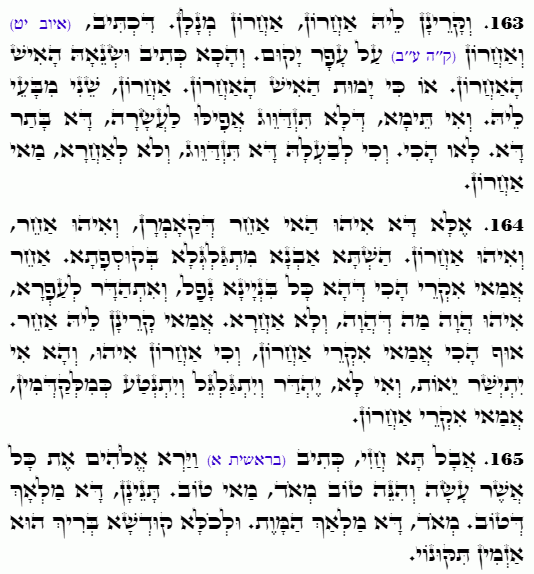Daily Zohar # 4787 – Mishpatim – And if the last man hates her
Daily Zohar 4787

Hebrew translation:
164. אֶלָּא זֶהוּ הָאַחֵר הַזֶּה שֶׁאָמַרְנוּ, וְהוּא אַחֵר, וְהוּא אַחֲרוֹן. עַכְשָׁו הָאֶבֶן מִתְגַּלְגֶּלֶת בְּכַף הַקֶּלַע. לָמָּה אַחֵר נִקְרָא כָּךְ? שֶׁהֲרֵי כָּל הַבִּנְיָן נָפַל וְחָזַר לְעָפָר, הוּא הָיָה מַה שֶּׁהָיָה וְלֹא אַחֵר. לָמָּה קוֹרְאִים לוֹ אַחֵר? אַף כָּךְ לָמָּה נִקְרָא אַחֲרוֹן, וְכִי הוּא אַחֲרוֹן? וַהֲרֵי אִם יִתְיַשֵּׁר – יָפֶה, וְאִם לֹא – יַחֲזֹר וְיִתְגַּלְגֵּל וְיִנָּטַע כְּמִקֹּדֶם. לָמָּה נִקְרָא אַחֲרוֹן?
165. אֲבָל בֹּא וּרְאֵה, כָּתוּב (בראשית א) וַיַּרְא אֱלֹהִים אֶת כָּל אֲשֶׁר עָשָׂה וְהִנֵּה טוֹב מְאֹד. מַה זֶּה טוֹב? שָׁנִינוּ, זֶה מַלְאַךְ הַטּוֹב. מְאֹד – זֶה מַלְאַךְ הַמָּוֶת. וְלַכֹּל הַקָּדוֹשׁ בָּרוּךְ הוּא הִזְמִין תִּקּוּנוֹ.
.
Zohar Mishpatim
Continued from previous DZ
#163
And he is called “אַחֲרוֹן” “Acharon” (the last one). From where do we know that he is called “Acharon”? As it is written:” וְאַחֲרוֹן עַל עָפָר יָקוּם” “And the last one will arise from the dust” (Job 19:25). Thus, a reincarnated soul (Gilgul) is called “Acharon” (the last one). Here, the verse states: “וּשְׂנֵאָהּ הָאִישׁ הָאַחֲרוֹן” “And if the last man hates her…” (Deuteronomy 24:3) or “כִּי יָמוּת הָאִישׁ הָאַחֲרוֹן” “Or if the last man dies…” (ibid.). He asks Why the Torah uses the term “Acharon” (last). It should have said “Sheni” (second) instead. And if you say that the Torah’s intention is to prohibit her from marrying ten men in succession—this is not the case. For why should she be allowed to marry this husband and not another? Why would she be forbidden to someone else? If so, why is he called “Acharon” (last one)?
Notes:
The Torah’s use of “Acharon” (last one) instead of “Sheni” (second one) alludes to the process of reincarnation. A reincarnated soul is considered “Acharon”, as it returns to complete its spiritual Tikun. The term does not imply a restriction on remarriage but rather reveals a deeper connection between reincarnation and marital unions.
#164
And he answers: This is the “אַחֵר” “Acher” (another) that we mentioned earlier—he is “Acher” (another), and he is also “Acharon” (the last one). For now, the stone is rolling in the hollow of the sling (כַף הַקֶּלַע, Kaf HaKela)—meaning that in relation to the first body that died, the reincarnated soul is considered to be in Kaf HaKela, having returned again to this world. Therefore, he is called both “Acher” (another) and “Acharon” (the last one). Since he has no destined soulmate, he takes the divorced woman as his wife. That is why the Torah refers to him as “Acher” (another) and “Acharon” (the last one). He asks: Why is he called “Acher” (another) in relation to the first body that died? After all, the entire structure (body) has fallen—that is, the first body has returned to dust as if it never existed. The reincarnated soul is the same as the original soul from the first body and not a new or different one. So why is he called “Acher” (another)? Similarly, why is he called “Acharon” (the last one)? Is he truly the last? If he rectifies his ways and attains correction, then indeed, he is Acharon, the final reincarnation, and he will not return again. But if he does not correct himself, he will reincarnate once more and be planted back into the world as he was before. If so, why call him “Acharon” (the last one) if he may not be the last?
#165
But come and see: It is written, “וַיַּרְא אֱלֹהִים אֶת כָּל אֲשֶׁר עָשָׂה וְהִנֵּה טוֹב מְאֹד” “And God saw everything that He had made, and behold, it was very good” (Genesis 1:31). What is “טוֹב” “good”? We have learned that this refers to the good angel. And “מְאֹד” “very” (me’od)—this refers to the Angel of Death. Yet the Holy One, Blessed be He, arranges all things toward their rectification until even the Angel of Death ultimately returns to become “very good.”
Notes:
Even the most feared force—the Angel of Death—has a role in the divine plan and will ultimately be transformed into goodness. All aspects of creation, even suffering and judgment, are part of a greater rectification that leads to ultimate harmony.
{||}

 Previous: Mishpatim
Previous: Mishpatim

